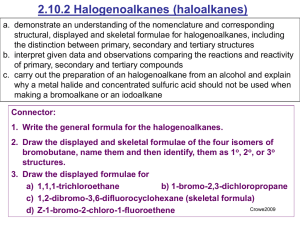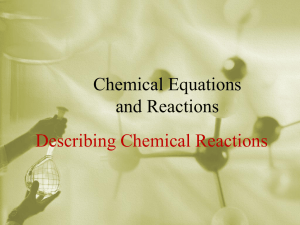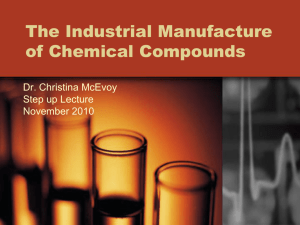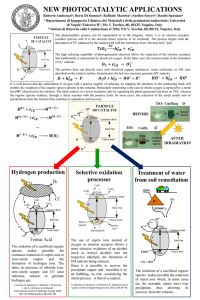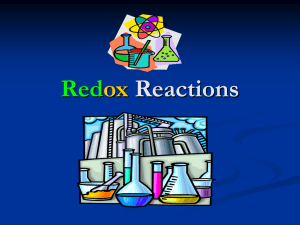here - A-level chemistry
advertisement
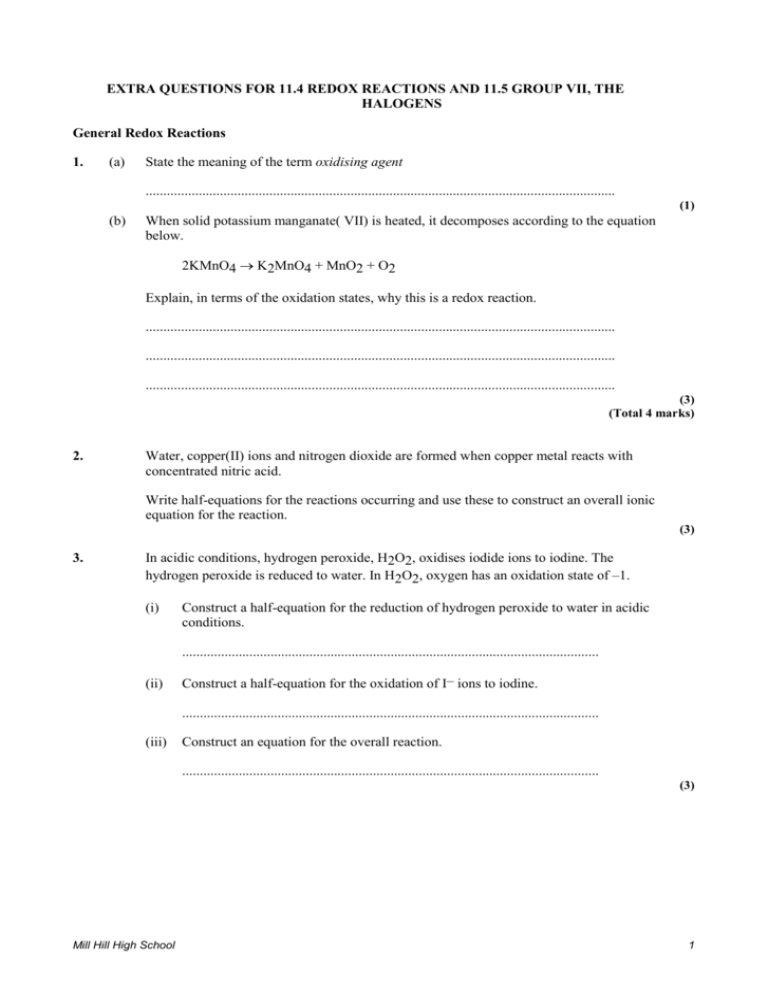
EXTRA QUESTIONS FOR 11.4 REDOX REACTIONS AND 11.5 GROUP VII, THE HALOGENS General Redox Reactions 1. (a) State the meaning of the term oxidising agent ..................................................................................................................................... (1) (b) When solid potassium manganate( VII) is heated, it decomposes according to the equation below. 2KMnO4 K2MnO4 + MnO2 + O2 Explain, in terms of the oxidation states, why this is a redox reaction. ..................................................................................................................................... ..................................................................................................................................... ..................................................................................................................................... (3) (Total 4 marks) 2. Water, copper(II) ions and nitrogen dioxide are formed when copper metal reacts with concentrated nitric acid. Write half-equations for the reactions occurring and use these to construct an overall ionic equation for the reaction. (3) 3. In acidic conditions, hydrogen peroxide, H2O2, oxidises iodide ions to iodine. The hydrogen peroxide is reduced to water. In H2O2, oxygen has an oxidation state of –1. (i) Construct a half-equation for the reduction of hydrogen peroxide to water in acidic conditions. ...................................................................................................................... (ii) Construct a half-equation for the oxidation of I– ions to iodine. ...................................................................................................................... (iii) Construct an equation for the overall reaction. ...................................................................................................................... (3) Mill Hill High School 1 Phosphorus is a more powerful reducing agent than nitrogen. 4. (i) Explain the meaning of the term reducing agent in terms of electrons. ........................................................................................................................... (ii) Suggest, in terms of atomic structure, why phosphorus is a more powerful reducing agent than nitrogen. ........................................................................................................................... ........................................................................................................................... ........................................................................................................................... (iii) The element phosphorus will reduce aqueous copper (II) ions to copper, being itself oxidised to phosphoric(V) acid, H3PO4. Write the half-equation for the oxidation of a phosphorus atom, in the presence of water, to phosphoric(V) acid. Deduce the ratio of copper (II) ions to phosphorus atoms in the overall equation for the reaction. Half-equation..................................................................................................... Cu2+:P ratio...................................................................................................... (Total 6 marks) 5. Sulphur and oxygen form many different compounds and anions. Some of these are illustrated in the following sequence of conversions. SO 2– 3 V S Step 1 S 2 O 2– 3 W I2 Step 2 S 4 O 2– 6 heat Step 3 SO2 + SO2– 4 +S X Y Give the oxidation state for each type of sulphur atom in each of the sulphur-oxygen species, V, W, X and Y. (Total 4 marks) Mill Hill High School 2 6. Write equations to support your answers in all parts of this question. (i) Reactions I and 2 described below are redox reactions. Write the appropriate reduction and oxidation half-equations for each of these reactions and hence construct an overall redox equation in each case. Include state symbols in all your equations. For each of these two reactions, identify the species reduced and state its oxidation state before and after reduction. Reaction 1: In aqueous solution, Ag+ ions react with metallic zinc to form Zn2+ ions and metallic silver. Reaction 2: In aqueous acid, NO3– ions react with metallic copper to form Cu2+ ions, NO2 gas and water. (ii) Write an equation for the reaction of ClO– ions to form Cl– ions and C1O 3– ions. Deduce the oxidation state of chlorine in ClO– and in C1O 3– . (Total 11 marks) Physical Properties of the halogens 7. The relative molecular masses of bromine, Br2, and iodine monochloride, ICl, are almost the same, yet their boiling temperatures are quite different. Account for this difference in boiling temperature. ..................................................................................................................................... ..................................................................................................................................... ..................................................................................................................................... ..................................................................................................................................... ..................................................................................................................................... (Total 4 marks) Mill Hill High School 3 8. (i) State the trend in the boiling points of the halogens from fluorine to iodine. ............................................................................................................................ (ii) Explain this trend. ............................................................................................................................ ............................................................................................................................ (iii) Give the physical states of chlorine, bromine, and iodine at room temperature, and deduce the likely physical state of astatine at room temperature. ............................................................................................................................ ............................................................................................................................ ............................................................................................................................ (5) 9. State and explain the trend in the electronegativities of the halogens from fluorine to iodine. Trend. .............................................................................................................. Explanation. .................................................................................................... .......................................................................................................................... (3) 10. State and explain the trend in electronegativity and the trend in boiling point of the halogens from fluorine to iodine. Trend in electronegativity........................................................................................... Explanation................................................................................................................. ..................................................................................................................................... ..................................................................................................................................... Trend in boiling point................................................................................................. Explanation................................................................................................................ ..................................................................................................................................... ..................................................................................................................................... (6) Mill Hill High School 4 11. (a) (i) Give the meaning of the term electronegativity. ............................................................................................................................ ............................................................................................................................ (ii) Explain why the electronegativity of the halogen atoms decreases from fluorine to iodine. ............................................................................................................................ ............................................................................................................................ (3) (b) How, if at all, does the decrease in electronegativity from fluorine to iodine affect the polarity of the bond between two identical halogen atoms in a halogen molecule? Explain your answer. Effect on bond polarity ............................................................................................... Explanation ................................................................................................................ .................................................................................................................................... (2) (Total 5 marks) 12. State and explain the trend in electronegativity down Group VII from fluorine to iodine. Trend ...................................................................................................................... Explanation ............................................................................................................ ................................................................................................................................ (3) 13. Explain why the boiling temperatures of the halogens increase down Group VII from fluorine to iodine (2) 14. Many interhalogen compounds and ions are known. Deduce the shapes of, and draw – – structures for, BrF 2 , BrF5, ICl 2 , ClF3 and ClF 4 . (15) Mill Hill High School 5 Redox Reactions of the Halogens 15. (i) Define reducing agent in terms of electron transfer. ............................................................................................................................ (ii) State and explain the trend in reducing power of the halide ions down Group VII. Trend in reducing power .................................................................................. Explanation ....................................................................................................... ............................................................................................................................ (iii) Justify your answer to part (ii) above by considering changes in the oxidation state of sulphur in reactions of concentrated sulphuric acid with sodium bromide and with sodium iodide. ............................................................................................................................ ............................................................................................................................ ............................................................................................................................ ............................................................................................................................ (7) 16. (a) Explain, with reference to electron transfer, what is meant by the term oxidising agent. ..................................................................................................................................... ..................................................................................................................................... (1) (b) State and explain the trend in oxidising power of the halogens fluorine to iodine. Trend ........................................................................................................................... Explanation ................................................................................................................. ..................................................................................................................................... ..................................................................................................................................... ..................................................................................................................................... (3) Mill Hill High School 6 (c) A redox reaction occurs when an aqueous solution of potassium iodide is mixed with an aqueous solution of chlorine. (i) State the colours of the original separate solutions and the colour of the mixture. Colour of aqueous potassium iodide ................................................................ Colour of aqueous chlorine .............................................................................. Colour of the mixture ....................................................................................... (2) (ii) Write an equation for the reaction. ........................................................................................................................... (1) (iii) Identify the reducing agent in this reaction. ........................................................................................................................... (1) (iv) Write half-equations (ion-electron equations) to show the reaction of the oxidising agent and the reaction of the reducing agent. Half-equation for the oxidising agent ........................................................................................................................... Half equation for the reducing agent ........................................................................................................................... (2) (Total 10 marks) 17. When concentrated sulphuric acid is added to separate samples of solid sodium bromide or sodium iodide and warmed, a mixture of gases is evolved. Some of these are reduction products of sulphuric acid. (i) Give the formula of each gaseous reduction product of sulphuric acid formed using these two halides. Gaseous reduction product(s) of H2SO4 using NaBr ............................................................................................................................ Gaseous reduction product(s) of H2SO4 using NaI ............................................................................................................................ Mill Hill High School 7 (ii) What other gases are evolved in these reactions? How if at all could they be recognised? ............................................................................................................................ ............................................................................................................................ ............................................................................................................................ ............................................................................................................................ ............................................................................................................................ (9) 18. (i) Write a half-equation for the conversion of HI into I2 ........................................................................................................................... (ii) Write a half-equation for the conversion of H2SO4 into H2S in the presence of H+ ions. ........................................................................................................................... (iii) Write a half-equation for the conversion of H2SO4 into SO2 in the presence of H+ ions. ........................................................................................................................... (iv) Use your answers to parts (i), (ii) and (iii) above to construct an overall equation for the simultaneous formation of one mole of H2S and one mole of SO2 in the reaction of HI with H2SO4 ........................................................................................................................... ........................................................................................................................... ........................................................................................................................... ........................................................................................................................... (5) 19. (a) Concentrated sulphuric acid can be reduced by some solid sodium halides to H2S (i) Give the oxidation state of sulphur in H2S ...................................................................................................................... (ii) Give one solid sodium halide which will reduce concentrated sulphuric acid, forming H2S ...................................................................................................................... (iii) State one way in which the presence of H2S could be recognised. ...................................................................................................................... Mill Hill High School 8 (iv) Write a half-equation for the formation of H2S from sulphuric acid. ...................................................................................................................... (4) (b) A different solid sodium halide reacts with concentrated sulphuric acid without reduction forming a halogen-containing product X. (i) Suggest an identity for X. ...................................................................................................................... (ii) Identify the solid sodium halide which produces X. ...................................................................................................................... (iii) State the role of sulphuric acid in the formation of X. (iv) ...................................................................................................................... Write an equation for the reaction with concentrated sulphuric acid in which X is formed. ...................................................................................................................... (4) (Total 8 marks) 20. When either solid potassium bromide or solid potassium iodide reacts with concentrated sulphuric acid, a mixture of gases is evolved. In each case, one of the gases is produced by oxidation. (i) Give the formula of the oxidation product formed in each reaction and state how this product would be observed. Oxidation product using KBr(s). ..................................................................... Observation. .................................................................................................... Oxidation product using KI(s). ....................................................................... Observation. .................................................................................................... (ii) State all the reduction products formed in these reactions and state which are formed in the reaction with KI, but not in the reaction with KBr. Reduction products. ......................................................................................... .......................................................................................................................... Product(s) formed only with KI(s). .................................................................. .......................................................................................................................... (iii) Identify the other gaseous products formed in these reactions. State the type of reaction by which they are produced. Other products. ................................................................................................ .......................................................................................................................... Mill Hill High School 9 Reaction type. .................................................................................................. .......................................................................................................................... (11) (Total 11 marks) 21. (a) When chlorine is dissolved in cold water a pale-green solution, chlorine water, is formed. A piece of universal indicator paper, dipped into chlorine water, first turns red and then becomes white. (i) Give the formula of the species responsible for the green colour of chlorine water. ........................................................................................................................... (ii) Write an equation for the reaction between chlorine and cold water. ........................................................................................................................... (iii) Explain the colour changes observed when universal indicator paper is dipped into chlorine water. ........................................................................................................................... ........................................................................................................................... (4) (b) Write an equation for the reaction that occurs when chlorine is bubbled into cold, dilute aqueous sodium hydroxide. ..................................................................................................................................... (1) (Total 5 marks) 22. Chlorine reacts with water as shown in the following equation. Cl2 + H2O Cl– + HClO + H+ In this reaction, chlorine acts both as an oxidising agent and as a reducing agent. (i) Construct a half-equation for the reduction of chlorine to chloride ions. ..................................................................................................................... (ii) Deduce the oxidation state of chlorine in HCIO. ..................................................................................................................... (iii) Construct a half-equation for the oxidation of chlorine, in reaction with water, to form HCIO and H+ ions. ..................................................................................................................... (iv) Give one reason why chlorine is used in the water industry ...................................................................................................................... (4) (Total 4 marks) Mill Hill High School 10 23. (a) When using silver nitrate to test for the presence of chloride ions in an aqueous solution, it is important to add another reagent to prevent interference by any carbonate ions which would form a white precipitate of Ag2CO3 (i) Identify this other reagent. ...................................................................................................................... (ii) Write an equation to show how this other reagent reacts with sodium carbonate. ...................................................................................................................... (2) (b) The presence of some halide ions in solution can be detected using aqueous silver nitrate and aqueous ammonia. (i) Identify a halide ion which, on addition of aqueous silver nitrate, forms a precipitate that is insoluble in concentrated aqueous ammonia. ...................................................................................................................... (ii) Identify a halide ion which cannot be detected using these reagents. ...................................................................................................................... (2) (c) A mixture of two precipitates, P and Q, was formed by adding aqueous silver nitrate to a solution containing two different halide ions. Precipitate P dissolved on addition of an excess of dilute aqueous ammonia. The remaining precipitate, Q, was filtered off. (i) Identify the halide ion in P. ...................................................................................................................... (ii) Precipitate Q was soluble in concentrated aqueous ammonia. Identify the halide ion in Q. ...................................................................................................................... (2) (Total 6 marks) 24. When concentrated sulphuric acid is added to each of the solid sodium halides NaCl and NaBr, a displacement reaction occurs and a hydrogen halide is formed. With NaBr, a further reaction takes place. This involves redox. (i) Write an equation for the reaction which leads to the formation of HCl. ........................................................................................................................... (1) (ii) HBr can reduce sulphuric acid to form a gaseous product which contains sulphur. Give the formula of the sulphur containing compound that is produced and state the oxidation number of sulphur in the compound. Compound .................................... Oxidation number ................................ (2) Mill Hill High School 11 (iii) Complete and balance the equation for the redox reaction which occurs between hydrogen bromide and sulphuric acid. HBr + H2SO4 (2) (iv) State what you would observe when concentrated sulphuric acid is added to sodium bromide. ........................................................................................................................... (1) (Total 6 marks) 25. (a) State how, and explain why, the reducing powers of the halide ions change down Group VII from fluoride to astatide. (4) (b) Use your knowledge of the reactions of solid sodium chloride, bromide and iodide to predict the gaseous products formed when concentrated sulphuric acid is warmed with solid sodium astatide. Identify the role of the astatide ion in the formation of each gaseous product and write equations for the reactions occurring. (9) (Total 13 marks) 26. (a) State what you would observe on adding aqueous chlorine to separate aqueous solutions of sodium bromide and sodium iodide. Write equations for the reactions occurring. (4) (b) State what you would observe on adding concentrated sulphuric acid to separate solid samples of sodium bromide and sodium iodide. In each case, identify all the reduction products. Using half-equations, construct an overall ionic equation for the oxidation of bromide ions by concentrated sulphuric acid. (9) (Total 13 marks) 27. Samples of solid sodium fluoride, sodium chloride, sodium bromide and sodium iodide are each warmed separately with concentrated sulphuric acid. All four compounds react with concentrated sulphuric acid but only two can reduce it. (i) Identify the two halides which do not reduce concentrated sulphuric acid. Write an equation for the reaction which does occur with one of these two halides. (ii) Identify the two halides which reduce concentrated sulphuric acid to sulphur dioxide. Using half-equations for the oxidation and reduction processes, deduce an overall equation for the formation of sulphur dioxide when concentrated sulphuric acid reacts with one of these halides. (iii) In addition to sulphur dioxide, two further reduction products are formed when one of these two halides reacts with concentrated sulphuric acid. Identify the two reduction products and write a half-equation to show the formation of one of them from concentrated sulphuric acid. (9) Mill Hill High School 12 28. Hydrogen chloride is readily prepared in the laboratory by the reaction of NaCl with concentrated sulphuric acid. Any attempt to prepare hydrogen bromide by a similar route, however, results in the formation of a mixture of products. (i) Write an equation for the reaction between NaCl and concentrated sulphuric acid. (2) (ii) Describe one observation you would make when concentrated sulphuric acid reacts with NaBr which you would not see when NaCl is used. State the role of the sulphuric acid in its reaction with NaBr. Account for the difference in behaviour of the halide ions in these reactions. (5) (Total 7 marks) 29. (a) How can the addition of an aqueous solution of chlorine be used to distinguish between aqueous solutions of sodium bromide and sodium iodide? State any observations you would make and write equations for the reactions occurring. (4) (b) How can reactions with concentrated sulphuric acid be used to distinguish between solid samples of sodium bromide and sodium iodide? State the observations you would make and give all the oxidation and reduction products formed in both reactions. Using half-equations, construct an overall equation for one of these redox reactions. (11) (Total 15 marks) 30. (i) State and explain the trend in oxidising ability of the elements down Group VII from chlorine to iodine. (ii) Explain how an aqueous solution of chlorine can be used to differentiate between separate aqueous solutions of sodium chloride, sodium bromide and sodium iodide. State what would be observed in each experiment and write equations for the reactions which occur. (13) Chlorine with water 31. Chlorate(I) ions are produced when chlorine is dissolved in cold water. (i) Write an equation for this reaction. ........................................................................................................................... (ii) The concentration of chlorate(I) ions in the aqueous chlorine solution can be increased by the addition of sodium hydroxide. Explain this observation and write an equation to show the effect of the sodium hydroxide. Explanation....................................................................................................... ........................................................................................................................... Equation............................................................................................................ (4) Mill Hill High School 13 32. (i) Define oxidation in terms of electrons. ........................................................................................................................... (ii) Give the oxidation state of chlorine in ClO– ........................................................................................................................... (2) 33. Write an ionic equation for the reaction which occurs when chlorine gas is bubbled into cold dilute sodium hydroxide and give a commercial use for the product of this reaction. Equation..................................................................................................................... Commercial use.......................................................................................................... (2) 34. When chlorine is bubbled into cold, dilute aqueous sodium hydroxide, an equilibrium is established. (i) Write an ionic equation for the equilibrium reaction between chlorine and hydroxide ions. ............................................................................................................................ (ii) Show that this is a redox reaction by considering the oxidation states of the chlorine-containing species in the equilibrium mixture. ............................................................................................................................ ............................................................................................................................ ............................................................................................................................ (iii) Identify the oxidising agent in the forward direction of the equilibrium and the reducing agent in the backward direction of the equilibrium. Oxidising agent in forward direction ................................................................ Reducing agent in backward direction ............................................................. (6) Test for halides 35. Describe what you would observe when aqueous silver nitrate is added to separate aqueous solutions of potassium fluoride and potassium bromide. Observation with KF(aq) ........................................................................................ Observation with KBr(aq) ...................................................................................... (2) Mill Hill High School 14 36. (i) An aqueous solution contains either chloride, or bromide, or iodide ions. Describe how you would identify the halide ion present. (ii) A different aqueous solution contains a mixture of chloride and iodide ions. Describe how you would confirm the presence of both of these halide ions in the solution. (11) 37. How would you distinguish between separate solutions of sodium chloride, sodium bromide and sodium iodide using solutions of silver nitrate and ammonia? (6) 38. Indicate how you could confirm the identity of hydrogen bromide gas using chemical tests only. (5) 39. The composition of a mixture of two solid sodium halides was investigated in two separate experiments. Experiment (1) When a large excess of chlorine gas was bubbled through a concentrated solution of the mixture, orange-brown fumes and a black precipitate were produced. Experiment (2) 0.545 g of the solid mixture was dissolved in water and an excess of silver nitrate solution was added. The mass of the mixture of silver halide precipitates formed was 0.902g. After washing the mixture of precipitates with an excess of concentrated aqueous ammonia the mass of the final precipitate was 0.564g. Write equations for each of the reactions occurring in these experiments and explain how these results enable you to identify the halide ions present. Use the information given above to calculate the percentage by mass of each halide ion present in the solid mixture. (15) Mill Hill High School 15



